Mantis boxing, which orginates from Eastern China, is a kung fu system which has distinctive characteristics and is famous both within China and overseas. With its distinctive characteristics it has attracted many experienced members of the martial arts world. Through hard training and dedication throughout the generations, mantis boxing has been refined and developed.
The following article was written by Zhou Zhen Dong and has been translated by Will-Wain Williams.
The history of Taji Praying Mantis
Wang Lang and Mantis 王朗 与 螳螂拳

When talking about mantis boxing, many people may be reminded of Wang Lang and his historic legend. In the story, Wang Lang is a handsome and skilful Wushu hero. He was defeated in a duel with a master of Tongbi style called Han Tong. Wang Lang was disappointed and set to training himself for a rematch.
He came across a praying mantis defending itself against a small bird. The mantis avoided the birds attack with great skill and body movement. Wang Lang had a talent for observation and realised the mantis’ movements could be studied and related to martial arts. Through several years of observation he created the unique style of mantis boxing. After creating the style, many people came to challenge Wang Lang and all were defeated. But this is all legend, what about the real history?
According to the Wushu dictionary published in 1985, Wang Lang was born around the end of Ming and beginning of Qing dynasty in Jimo district. At that time Jimo was under the administration of Laiyang County, so people also called Wang Lang “Laiyi”. According to this source, Wang Lang was a leading member in a revolutionary movement to overthrow the Manchu invaders, who started the Qing, and restore the Ming dynasty. After failing in the revolution, Wang Lang retreated to the mountains.
The existence of Wang Lang seems to be true, but how much contribution did he make to mantis boxing? According to my master (Zhang Kai Tang), through decades of combat he created “the mantis shape” and applied it successfully building a strong reputation. However he didn’t create the entire system, only the “mantis shape”, which was the beginning of the system. It seems the person who really created the system of mantis can’t be confirmed by any sources. Wang Lang can however be a figure the followers of mantis can admire and respect.
Li Bing Xiao and Zhao Zhu 李秉霄 与 赵珠
According the Laiyang History Annals, Li Bing Xiao accompanied his father in the south. There, a man in prison had fallen sick, so a prison guard requested a doctor. Li Bing Xiao was a very good doctor, so he went to read the thief’s pulse and treat him. After recovering, the thief ran away in the night.
Several months later, Li Bing Xiao was at home alone when the thief arrived suddenly at his home and thanked him for saving his life. They talked for a while and the thief agreed to teach him kung fu. Li Bing Xiao was talented and learnt quickly. After that the thief left and was never seen again.
The thief in this story was the first master of mantis boxing as remembered by all the successive generations. Who he was, and where he learnt mantis boxing is a mystery; only the name “heroic thief” has remained.
Li Bing Xiao, also known as “Li Er Gou” (Li 2 ditches), is the second master listed in the genealogy. His life is also full of amazing tales. During his youth, Li Bing Xiao was a scholar. However he failed the imperial exam and then fled to live in the mountains in recluse. His circle of friends was all swordsmen and Li Bing Xiao was fond of travelling around. However he never used his real name in public. It was said Li Bing Xiao was highly criticial of society and he cared nothing for the outside world. He was regarded a sage. His unique life had a great influence on the development of mantis boxing.
Zhao Zhu, also known as Qi Lu was the third master. According to Laiyang History Annals, Zhao Zhu was Li Bing Xiao’s best disciple. One time he was lying in bed when a thief broke in. Zhao Zhu merely waved his arm in the air and the thief collapsed on the floor. Surely this level of kung fu would be admired by everybody.
Zhao Zhu was taught by Li Bing Xiao and trained himself every day. After several years he had mastered the entire system. One winter he escorted his master to the river ferry to return home for Chinese New Year. At the river bank Master Li said to Zhao Zhu “I have taught you everything, the only thing left is Qing Gong (light body skills)”. With that jumped onto the thin ice and within seconds had run across the entire river! Li Bing Xiao’s internal power was incredible, so we can find mantis boxing is also a great internal system. Unfortunately, Li Bing Xiao never returned to teach the skill as he got ill and died. The skill “flying like a swallow” was never passed on, only this story to leave us to dream.
Liang Xue Xiang 梁学香
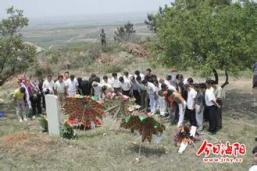
According to the Laiyang History Annals, Liang Xue Xiang was the fourth master of mantis boxing. Liang was physically short and thin, but his movements were fast and powerful. Once he asked his students to get an “eight immortals table”, and he went underneath the table and started performing his kung fu, his long clothes never even got tangled up. During a competition he killed a man with a single blow and gained the name “Liang the hammer”. In other aspects he was physically weak however. His father often criticised him as he couldn’t even carry a sack of rice or do farm work in his youth. From this we can make the conclusion that the power required in kung fu is different to the power required for physical labour. This is internal and external power.
Liang Xue Xiang worked as a bodyguard escorting good s caravans to the north. After one particularly dangerous battle, he decided to quit. That time he was escorting caskets of silver. They got as far as Cangzhou in Hebei province. The time was late so they hitched up at a local inn. Suddenly a group of about thirty or forty armed robbers gathered. Liang grabbed a long plank of wood and fought them off in the yard. The scene was a mess and so noisy nobody could hear a thing. Suddenly Liang’s plank of wood got hacked up, so he had to fight them barehanded. The robbers eventually fled and Liang and his team left Cangzhou. During the fight, Liang had got injured in his right eye and became blinded. Since then he got the nickname “One eyed Liang”.
After that event, Liang gave up his job and took his experience back to his hometown of Haiyang to teach mantis boxing. Master Liang was the first master to document mantis boxing in writing.
In his old days his disciple Jiang Hua Long had a house built for him. Liang went to see the house and said “this isn’t well built at all!” Jiang disagreed, claiming he had used the best materials. Liang didn’t say anything; he just struck a wall with his hip and made a huge crack down the wall! (This house is in a small village in Haiyang and the crack can still be seen to this day.)
His good condition didn’t last forever, one autumn after practicing the form Luan Jie, he sat on a chair, closed his eyes and died.
Jiang Hua Long and Li Dan Bai 姜化龙 与 李丹伯
The fifth master of mantis boxing in Laiyang was Jiang Hua Long. According to the Laiyang History annals ” Mr Zhu often said, ‘my footprints have touched seven provinces, I don’t need to worry if one thousand people attack me. There are only two people who I hold in awe; one is Mr Zhen from Shanxi, the other is Jiang Hua Long…… Hua Long is from Huang Jin Gou village, studies mantis boxing….. his height is barely five foot and he is overweight. He looks completely useless, but when you try to get close to him, you immediately feel his speed and power is like a strong ape…….”
In his young age Jiang Hua Long started training under Liang Xue Xiang. However, due to his young age he liked to play and was always naughty. He didn’t train hard and thought highly of his own skill. His master saw talent in him, so much that others couldn’t compare to him; so he couldn’t stand to watch him grow up in this bad way. So one day Master Liang wrote a letter to his elder student and asked little Jiang to take it to him. He wanted to teach the kid a lesson. When the elder student received it, he immediately beat the child! Little Jiang ran back to his master crying to tell him what happened. Master Liang scolded him, saying “look at you, such great kung fu and you can’t even fend for yourself against others!” Little Jiang realised the error of his ways and that his master cared about him. He changed his outlook and trained as hard as he could and eventually became the next inheritor to the system of mantis.
Jiang Hua Long’s character was tough and enduring. He really enjoyed fighting; so much so that as soon as he heard a new school opened, he would go and challenge them! Many teachers made a living from their kung fu, so they deeply hated Jiang and often plotted against him. One time, several masters got together to attack him while he went to the toilet. While he was in the middle of his business, they all ganged up on him. Luckily, he managed to beat them all off, and later they were all very worried he wouldn’t let it go. They convinced the village elders to pacify Jiang; due to their position, he had no choice but to accept the apology.
During Jiang’s lifetime, more and more people began learning mantis boxing, and would mix the mantis posture with other styles, creating new forms. As many new branches appeared, so mantis boxing became more popular. When talking about Jiang Hua Long, we must also mention Li Dan Bai. Towards the end fo the Qing dynasty and beginning of the republic, these two men had big reputations as fighters; their kung fu was considered “as high as Mount Tai”. Li Dan Bai had originally studied Chang Quan (long fist) and enjoyed fighting even more than Jiang. Every time he learnt a new move, he would go out and test it out against members of other schools. As his school was held responsible, his master had no choice but to expel him. At that time, other schools would not accept a student who had been expelled, so he never found another school to train at.
When Li Dan Bai was training at the Chang Quan school, he learnt one form, which became known as the unbeatable Zhong Lu Fan Che. He put his blood and sweat into the form in a way no modern person could match. Master Zhang Kai Tang said about him “as soon as he lifted a hand and stepped a foot, the dirt on the ground flew up, his power was unmatched. When doing this form, he looked like a dragon rising up. When he fought his long sleeves whipped against the floor creating a blinding whirl and sending dirt into the opponent’s eyes and he moved in to attack.”
Jiang Hua Long heard of this unbeaten man and went to find him. He saw him at the challenge ground in a yellow outfit, Master Jiang was wearing green. He mounted the platform and mocked Li. The two stood facing each other, both undefeated; what a sight it must have been!
Master Zhang Kai Tang described the event as a match between a yellow dragon and a green butterfly. The two were fairly evenly matched, but eventually Jiang knocked Li out and was victorious.
Jiang Hua Long and Li Dan Bai became like brothers after this event. They exchanged techniques and Li gave Jiang his notorious form “zhong lu fan che”, as well as a heavy spear form, and in return Jiang taught him mantis boxing. In later years, Li Dan Bai defeated all opponents who came and opened many schools. However due to overtraining hard techniques, he became disabled and required the help of others to do simple daily tasks. Jiang Hua Long stayed in Laiyang and taught many students well into old age.
Song Zi De and the “three mountains two pavilions” 宋子德 与 三山两亭
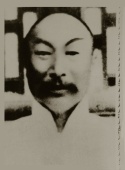
According to the Laiyang history Annals, Song Zi De (pictured to the left) who also went by the name Song Yao Kun, was the sixth generation master of Mantis boxing.
The Song family was a very rich family which owned a lot of land around Laiyang. Due to his comfortable life, Song Zi De didn’t have to work hard and so could devote all his time to training kung fu. He spent a lot of time researching many styles of kung fu and had a deep understanding of mantis boxing. Master Zhang said of Song Zi De that in the development of mantis boxing, he was the most important person.
Song Zi De looked very soft and unassuming, but he had immense power. Whenever he went into Laiyang, people would come to challenge him; with one movement, he would send them flying away. Master Song taught hundreds of people in his life, but his most famous students were known as “3 mountains 2 pavilions” (mountain in Chinese is Shan, pavilion is Ting). They were Cui Shou Shan, Li Kun Shan, Wang Yu Shan, Song Fu Ting and Zhao Xi Ting. These five students trained with their whole heart, as well as receiving extra care from Master Song, and mastered the entire system of mantis boxing.
Amongst the “3 mountains 2 pavilions” Song Fu Ting was the grandson of Song Zi De. He was very talented in martial arts, but was a lonely person and spent his days at home training by himself. Apart from occasionally overseeing classes at the kung fu school, he took no formal students of his own.
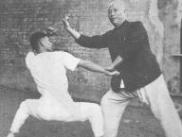
Li Kun Shan (pictured right) was the grandson of Li Dan Bai; he actually studied under Jiang Hua Long. Li Kun Shan took part in a national kung fu competition where he beat all competitors in free fighting and was awarded a gold medal for spear by Chiang Kai Shek himself. Later Li Kun Shan relocated to Taiwan where he opened a school and the art spread overseas from there.
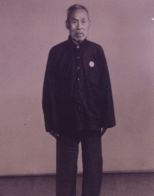
Wang Yu Shan (on the left) moved to Qingdao where he opened up a school, and had many students too.
Zhao Xi Ting’s life was unrecorded.
Cui Shou Shan and the Mantis Texts 崔寿山 与 螳螂拳谱
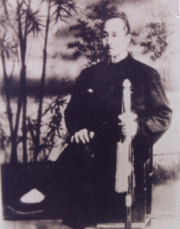
Master Cui Shou Shan became known as the seventh generation in our lineage. Master Cui opened the National Martial arts school in Laiyang, then later moved to Da Lian city (Liaoning province, northeast China) to teach. During the 1930’s Master Zhang Kai Tang invited him to move to Yantai to live with him and teach him mantis boxing.
Master Cui had three main disciples: Ji Chun Ting, Zhang Kai Tang and Sun Xiang Ting.
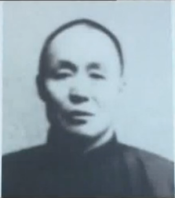
Ji Chun Ting originally learnt from Song Zi De for a short time, and then sought out master Cui. He informally taught Hao Bin of Hao family Meihua mantis, who moved to Qingdao where he spread the art.
While living in Yantai, Master Cui’s son was sick. He was cured by Sun Xiang Ting and so Master Cui taught him mantis to thank him. Sun Xiang Ting never took any disciples.
In his lifetime, his greatest achievement was in writing a complete manuscript on mantis. The manuscript begins with:
“Martial arts may be departed into the internal and external families. The external draws its roots from Shaolin, and emphasises combat effectiveness. The internal uses stillness to overcome movement, and originates from a man named Zhang San Feng. Song Yi had a high level of martial skill, and even united the country. But his skill was only external; he had mastered Chang Quan. During the Ming Dynasty, the borders of China had a lot of conflict, and a lot of brave warriors were recruited by rebellious states. Master Li was the greatest; he had learnt all 18 skills. During the Qing Dynasty, there were two departments of government; military and civil, but they both used the same examination system. At that time, Li Bing Xiao, who was a scholar, didn’t pass the imperial examinations and so went into recluse in the mountains. He spent a long time living amongst swordsmen and warriors. He knew many skilled masters, and mastered both internal and external together; formulating the system of mantis. He travelled around, but didn’t use his real name, so he avoided fame. He passed on his skills to Master Liang, named Xue Xiang. He passed away and Master Jiang, named Hua Long inherited the skills. Master Jiang passed the skills onto my teacher, Master Song Zi De, also named Yao Kun. Up to now it has about 100 years of history. Song Zi De passed it on to Peng Nian and some other students. He wasn’t very clever and couldn’t meet Song Zi De’s requirements, but when he practiced with other students, when he came across an idea, he would write it down and now I have researched his notes. When Master Song came across some principles during his training and fighting, he wrote it down. Now I have gathered and collected these notes to make this text. I hope this content; whoever receives this knowledge can pass this on. I wish whoever could get this from Song Zi De could pass it down too, as I admire his virtue. I worry after a long time, the skills will be lost, so I write this down so as to encourage myself.”
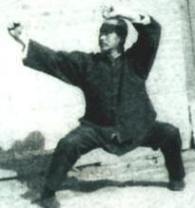
This manuscript expounds mantis boxing in great detail; giving the later generations a first-hand picture of mantis boxing. It expounds the methods of correct use of power and body mechanics, as well as combat application of the art. In this way it exceeds any other written texts on martial arts.
Cui Shou Shan passed on his art to Zhang Kai Tang, then returned to Laiyang, where he passed away in 1969.
Zhang Meng Jia & Zhang Kai Tang 张蒙家 与 张楷堂
In the city of Yantai, the Zhang family have run a kung fu school since the Ming dynasty. Later on, the family became rich. Before the revolution they were the richest family in old Yantai. When Zhang Meng Jia was young he worked hard and business was really successful, this enabled him to devote his energy to mantis boxing.
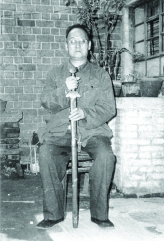
Zhang Meng Jia originally knew of mantis boxing through Jiang Hua Long, but because he didn’t train hard enough, he didn’t attain a high level. In fact, Zhang Meng Jia’s hobby wasn’t really kung fu, but chess. Later he invited Song Zi De to his home to teach him kung fu, but really wanted to learn chess. Master Song once asked Zhang “little brother, what do you understand about Master Jiang’s teaching?” He turned his glass and replied “my understanding of kung fu all went into my stomach with this alcohol!” Although he didn’t really attain much in kung fu, he had a good relationship with the main branch of mantis masters.
Zhang Kai Tang (pictured seated with disciple Zhou Zhen Dong) was the grandson of Zhang Meng Jia and he really liked kung fu. Originally he studied the Hao family Meihua mantis. At that time, the Hao family were very famous in Yantai and their forms included Luohan Quan, Meihua Pi (later renamed Taiji Pi), Tie Sha Zhang and Chuan Zhi. The founder, Hao Lian Ru was friends with Liang Jing Chuan (son of Liang Xue Xiang) and studied the form Luan Jie from him, which he combined with his own knowledge to create the Hao family style. Master Zhang learnt from Hao Heng Lu and Hao Heng Xin (two sons of Hao Lian Ru) for six years, and mastered their art.
In the beginning of the 1930s, Master Zhang and Zhang Meng Jia went to Dalian to invite Cui Shou Shan to their home to teach martial arts. Because Zhang Meng Jia was well known to the martial arts circles, Master Cui agreed. Master Zhang provided Cui Shou Shan with four plates and six bowls of food a day. Every year he paid 300 Da Yang, a price higher than any other!
Master Cui soon found out Zhang Kai Tang excelled in martial arts. He really trained as hard as he could. Master Cui to him “when you practice, you look just like my master!” But Zhang Kai Tang was very humble and didn’t boast. He trained as hard as he could and mastered the entire system in just six years. Zhang Kai Tang practiced every day without fail, people said he was the top student of Cui Shou Shan, but he dismissed this claim. In 1993 he passed away at the age of 83.
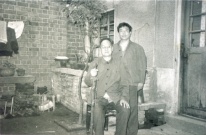
(Zhang Kai Tang passed the art onto his own sons, as well as my shifu, Zhou Zhen Dong. Zhou Zhen Dong is currently the only person teaching the art of Zhang Kai Tang, which includes the Taiji Mantis of Cui Shou Shan as well as the old forms of the Hao family.)
Article originally posted on //www.monkeystealspeach.co.uk

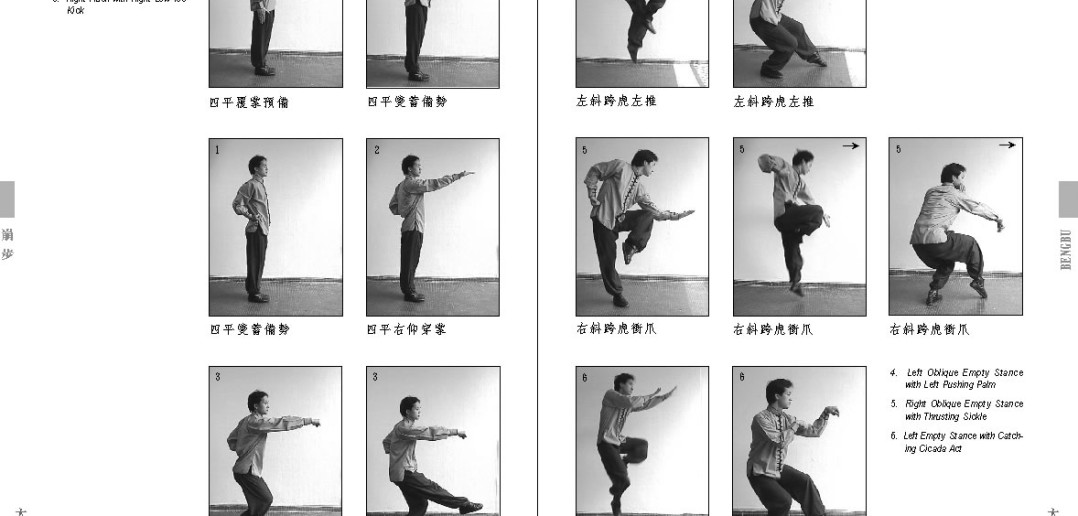
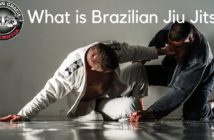


1 Comment
This The History of Taji Praying Mantis site has helped me
many times in health problems. This book helped me
to heal and feel better: https://s96.me/herbal-remedies Kiss you all!